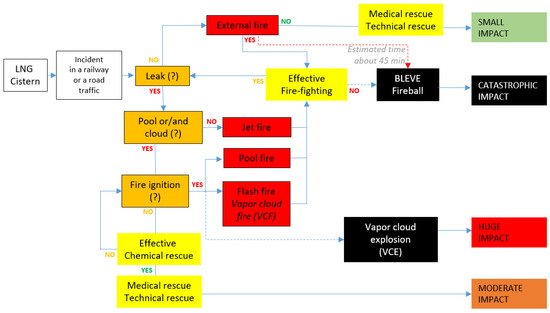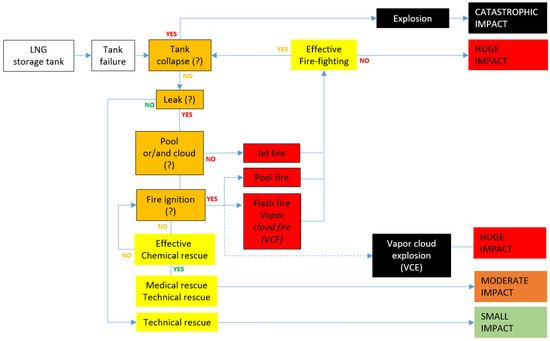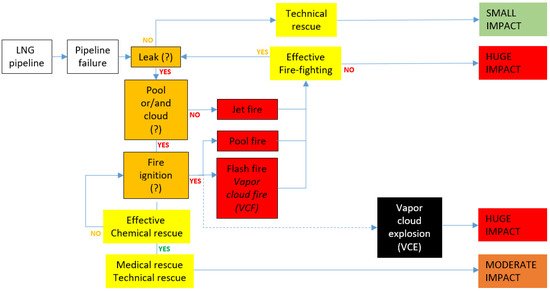2. Current Studies
Figure 1,
Figure 2 and
Figure 3 present the conventional event trees in three different versions reflecting potential LNG incidents in critical infrastructure objects playing a key role in the gas distribution. There are three cases elaborated: road and railway transport, a storage tank and a pipeline. These cases are elaborated towards three crucial scenario line developments, which are dispersion without fire, dispersion with ignition and explosion. Each of the trees reflects these three potential scenario lines, determined from the literature review and field tests. Real cases of such incidents might be found in the referenced sources to the article, e.g., [
3,
8].
Figure 1. LNG conventional event tree for road and railway transport.
Figure 2. LNG conventional event tree for a storage tank.
Figure 3. LNG conventional event tree for a pipeline.
Moreover, in these trees, a particular scenario line flow is conditioned by incident commander decisions and the effectiveness of emergency mitigation measures introduced on certain phases of the overall scenario development. In this respect, the orange boxes reflecting “decision points” and the yellow boxes reflecting effective emergency response measures (“learning curves points”) are essential. These elements of the trees are conditional and depend on the decisions and performances of trainees during the training/exercise being evaluated by trainers. Solid lines depict more likely scenario flow, while the dotted ones suggest less probable development (red dotted line reflects low probability high impact sub scenario).
Each combination of the scenario flow is ended with a generalised assessment of potential impact generated by the analysed incident. The categorisation of the impact is formulated on the basis of the literature review presented in the Background information section; however, it is definitely to be underlined that the impact strongly depends on the hazard (e.g., volume of LNG), exposure (the character of the vicinity of the incident, e.g., industrial, urban, etc. as well as weather conditions) and vulnerability of the exposed people, infrastructure and natural environment. As such, the suggested impact is, to a certain extent, generalised.
LNG conventional event trees are designed and shaped in order to be used for training and exercising purposes. Primarily, they can facilitate designing and creating scenarios for such didactic events. However, the key value of the concept is the ability to use ‘decision points’ (labelled orange) and ‘learning curve points’ (labelled yellow) for active learning and training purposes. The overall idea is that the abovementioned moments of a training or exercise are key moments when trainees get to actively interact with their trainers in a table-top event. This interaction is devoted to recognising the trainee’s knowledge and skills on a specific topic related to the particular moment of the scenario flow. However, if the didactic event is a full-scale exercise/training or drill, by analogy to the table-top, the trainers are obliged to closely observe the performance of the trainees in the given points of the scenario flow. This needs to be done in order to assess the trainees’ competencies which, in the case of the table-top, is done in the form of a discussion. On the basis of the acquired data by discussion and/or observation, the trainers decide on the optimal path of the further development of the scenario. The trainers’ decision is obviously related to the aims of the training/exercise but also on some other aspects like the level of performance of the trainees in a ‘decision point’ or in a ‘learning curve point’, the level of difficulty the training/exercise is expected to force on the trainees, the optimal learning path for a given trainee in the given context of his/her mental and physical disposition on that particular day. Such an approach guarantees a certain level of flexibility stimulated by the trainers, which positively influence achieving optimal learning outcomes for the given trainee on a given day.
Methodologically, training is conducted by specialised trainers on the basis of the abovementioned ‘decision points’ and ‘learning curve points’. The methodical assumption allows them to verify existing, and to form new, qualifications of the trainees in terms of their knowledge, skills and social competencies (e.g., by discussion during table-top). The latter are mainly due to the possibility of conducting the training in a team setting, reflecting different roles of the trainees, e.g., incident commander, chemical rescue team leader, rescuer, etc. The ‘decision points’ and ‘learning curve points’ are didactic pauses during training to allow contact with trainers for problem-solving discussions at key moments in the scenario development. Hence, the trainer may discuss corrective actions with the trainees when they realise the trainees acted inadequately regarding the situation and the standard operating procedures. The same relates to a situation while the trainees decide on a response measure, which is not acceptable at the given moment of the scenario and its context, from a risk assessment perspective. All such learning curves are recommended for in-depth elaboration between the trainers and trainees. Regardless of the form of training, as well as the setting of the simulation and gameplay (in stationary facilities, e.g., simulation with film or in field conditions with gas or LNG simulators), the ‘points’ allow decisions and planned actions in the face of the situation arising from the scenario at a given moment of its development to be determined with the trainees. On the basis of these decisions, made depending on the sophistication of the trainees with more, less or no support from the trainers, the trainers decide on the further path for the training to take according to the scenario schemes developed. Thus, the training is characterised by open scenarios. The final variant of the applied scenario path during a given training/exercise depends on the trainers and their evaluation of a number of decisions made by the trainees at each ‘point’.
The concept has the didactic value of interaction with the trainers at different stages of the training/exercise. In addition, the pace of training implementation is dictated by the trainers based on ongoing monitoring and evaluation of participants’ decisions, actions and behaviours. It also allows trainers to adjust the difficulty level of the scenario to the progress of the participants during a given training flexibly and on an ongoing basis, for example, by increasing or decreasing the didactic pressure on them (limiting the time for decisions, introducing additional variables to the problem situation, e.g., more victims, spills dynamic and structure, limiting the availability of resources at the scene, e.g., due to delayed arrival of a specialised chemical rescue team, etc.). Despite the freedom of trainers in the variation of the scenario, allowing for their adaptation to the training/exercise purposes and aims, and the participants’ condition on the day, the main scenario paths remain constant. This is a prerequisite, as previous research has shown that there are several main scenarios for the development of LNG accidents, which are foreseen in the developed schemes presented in this paper.
The proposed didactic form activates the trainees at each stage of the scenario, which positively influences their achievement of the desired learning outcomes. In addition, it enables the active formation of new knowledge, skills and social qualifications and allows the trainee to review and revise existing competencies. This is made possible by a reflective self-assessment by each participant at scenario ‘points’ with the mentoring support of the trainers. The level of support offered by the trainers at the ‘points’ should correspond to the learning goals and objectives of the training/exercise as well as to the pre-reception level of the trainees.
It is also worth emphasising that ‘points’ allow trainers to collect the necessary data to evaluate the didactic progress of the participants. Depending on the training objectives and the profile of the trainees, the trainers may place more or less emphasis on a certain range of rescue activities during a specific training/exercise session. The purpose of the concept is to quantitatively verify whether the trainee has covered the optimal range of competencies assigned to him/her in the realisation of the objective function, which is to minimise the risk of catastrophic consequences of a LNG event (according to the scenario diagrams developed in this paper). Moreover, in qualitative terms, trainers assess whether and how a given participant, as well as the entire training team (e.g., tactical union in the form of a platoon, specialist rescue group or various other configurations), applied functioning procedures, rules, good practices, as well as what decisions were made at a given ‘point’ by persons in charge of the rescue operation (e.g., incident commander, chemical rescue team leader). To this end, the trainers will, depending on the objectives of the training/exercise, formulate their expectations for decisions, rescue actions and measures to be taken by the trainees at the ‘point’ during the development of the evaluation method. The reference material for the trainers to develop the abovementioned requirements should be constituted by legal regulations, internal regulations of the rescue system (e.g., guidelines), but also the so-called good practice developed through previous experience and knowledge of the trainers. It is proposed that the training/exercise introduction, as well as didactic materials, should be available for upcoming trainees before the training/exercise to enable them to prepare for it theoretically, e.g., in the form of self-study or e-learning [
41].
Apart from having a well-founded professional knowledge and skills in this area to evaluate the content of the participants, trainers should be methodically prepared for the task of evaluating the participants. Besides solid competencies and experience in the field of chemical rescue, the trainers should acquire their methodical competence through training, workshops or other didactical forms on methods and techniques of evaluation of trainees. Such training should contain contents concerning the evaluation process as an object of cognition. Thus, it should include basic mechanisms and phenomena inherent in the theory of cognition, taking into account elements of psychology, including social psychology (e.g., “two systems of thinking”, “cognitive errors”, etc.), especially in the context of evaluating people and phenomena. Moreover, the training should lead to trainers’ acquisition of so-called soft competencies in the area of maintaining proper mentoring. Trainers should have an authority based on their competencies and attitudes towards trainees. Methodologically, the training should provide trainers with the knowledge and skills to use appropriate methods, techniques (e.g., OAJR—observe-analyse-judge-recommend) and evaluation tools to objectivise the evaluation process (e.g., using at least two trainers to evaluate the same aspects) [
42]. In general, the evaluation should provide information in three areas:
-
The didactic progress of the trainees;
-
Strengths and weaknesses of LNG response, including suggestions for improvement [
34,
38];
-
Opportunities to improve the training method, including the evaluation method, for further development and improvement of the training/exercising concept.
Thus, the primary task of the evaluation process is to verify the level of learning outcomes achieved by individual trainees. Moreover, the evaluation should provide the necessary feedback from the trainees on how to improve this form of training and how to evaluate the trainees. Such an approach, i.e., the use of methodically grounded stages of training organisation, starting with the definition of its objectives, then evaluation methods adjusted to these objectives, and further organisational steps, will provide a logical and organisational continuum, both with regard to one specific training, as well as the whole, self-improving system, of training and rescue [
43].
It is worth noting that the concept allows for feedback from the participants on the level of preparation and execution of the training/exercise, which fits into the third proposed evaluation objective. This makes the concept open for continuous improvement of the training/exercise content and forms.
Another advantage is its versatility and, therefore, the possibility of implementation within practical staff and application exercises.



